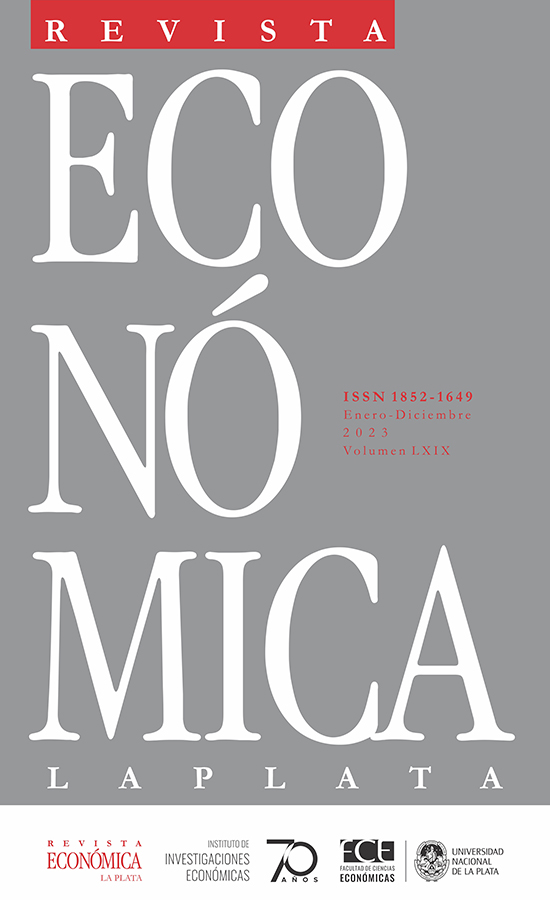Efectos del primogénito en los resultados laborales de las madres: evidencia para América Latina
DOI:
https://doi.org/10.24215/18521649e030Palabras clave:
Oferta laboral femenina, preferencia por el primer hijo varón, comportamiento de las madresResumen
Esta investigación muestra que en algunos países de América Latina las mujeres cuyo primer hijo es un niño tienen menos probabilidades de trabajar que las mujeres con primogénitas. El objeto de estudio es tratar de entender por qué las mujeres reaccionan de esa manera. Para ello se puso a prueba la hipótesis del efecto de deseo por hijo niño (Dahl y Moretti, 2008) y del efecto divorcio (Bedard y Deschenes, 2005; Ananat y Michaels, 2008), a partir de una estrategia de identificación que considera que el sexo del primer hijo en la concepción es aleatorio.
Referencias
Almond, D. y Currie, J. (2011). Human capital development before age five. En D. Card y O. Ashenfelter (Eds.), Handbook of Labor Economics (1ª ed., Vol. 4B, Cap. 15, pp. 1315–1486). Elsevier. https://doi.org/10.1016/S0169-7218(11)02413-0
Ananat, E. O. y Michaels, G. (2008). The effect of marital breakup on the income distribution of women with children. The Journal of Human Resources, 43(3), 611–629.
Azimi, E. (2015). The effect of children on female labor force participation in urban Iran. IZA J Labor Develop, 4, 5. https://doi.org/10.1186/s40175-015-0030-x
Barcellos, S., Carvalho, L. y Lleras-Muney, A. (2014). Child gender and parental investments in India: Are boys and girls treated differently? American Economic Journal: Applied Economics, 6(1), 157–189. https://doi.org/10.1257/app.6.1.157
Bedard, K. y Deschenes, O. (2005). Sex preferences, marital dissolution, and the economic status of women. The Journal of Human Resources, 40(2), 411-434.
Bharadwaj, P. R., Dahl, G. B. y Sheth, K. (2013). Gender discrimination in the family. En E. Redmount (Ed.), The Economics of the Family: How the Household Affects Markets and Economic Growth (Vol. 1, pp. 237 266). Praeger.
Carneiro, P. y Ginja, R. (2014). Long-term impacts of compensatory preschool on health and behavior: Evidence from head start. American Economic Journal: Economic Policy, 6(4), 135-173. https://doi.org/10.1257/pol.6.4.135
Choi, E. J. y Hwang, J. (2015). Child gender and parental inputs: No more son preference in Korea? American Economic Review, 105(5), 638–43. https://doi.org/10.1257/aer.p20151118
Dahl, G. B. y Moretti, E. (2004). The Demand for Sons: Evidence from Divorce, Fertility, and Shotgun Marriage (NBER Working Paper Nº10281). National Bureau of Economic Research
Figlio, D., Hamersma, S. y Roth, J. (2009). Does prenatal wic participation improve birth outcomes? New evidence from Florida. Journal of Public Economics, 93(1-2), 235–245. https://doi.org/10.1016/j.jpubeco.2008.08.003
Firpo, S., Fortin, N. M y Lemieux (2009). Unconditional quantile regressions. Econometrica, 77(3), 953–973.
Gasparini, L. y Marchionni, M. (2015). Bridging Gender Gaps? The Rise and Deceleration of Female Labor Force Participation in Latin America: An overview (Documento de Trabajo Nº185). CEDLAS, Universidad Nacional de La Plata. http://hdl.handle.net/11336/57042
Ichino, A., Lindström, E. A. y Viviano, E. (2011). Hidden consequences of a first-born boy for mothers. Economics Letters, 123(3), 274-278.
Jayachandran, S. y Kuziemko, I. (2011). Why do mothers breastfeed girls less than boys? Evidence and implications for child health in India. The Quarterly Journal of Economics, 126(3), 1485–1538.
Koenker, R. y Bassett, G. (1978). Regression Quantiles. Econometrica, 46(1), 33–50.
Koenker, R. (2005). Quantile Regression (Econometric Society Monographs). Cambridge University Press. https://doi.org/10.1017/CBO9780511754098
Kulczycki, A. (2011). Abortion in Latin America: Changes in Practice, Growing Conflict, and Recent Policy Developments. Studies in Family Planning, 42(3), 199-220. https://doi.org/10.1111/j.1728-4465.2011.00282.x
Levine, P. B. y Schanzenbach, D. W. (2009). The impact of children’s public health insurance expansions on educational outcomes (Working Paper Nº14671). National Bureau of Economic Research.
Lundberg, S. (2005). Sons, daughters, and parental behaviour. Oxford Review of Economic Policy, 21(3), 340–356. https://doi.org/10.1093/oxrep/gri020
Lundberg, S. y Rose, E. (2002). The Effects of Sons and Daughters on Men’s Labor Supply and Wages. The Review of Economics and Statistics, 84(2), 251–268.
Minnesota Population Center. (2020). Integrated Public Use Microdata Series, International (Version 7.3) [Data set]. https://doi.org/10.18128/d020.v7.3
Publicado
Número
Sección
Licencia
Derechos de autor 2023 Carlos Salas Peña

Esta obra está bajo una licencia internacional Creative Commons Atribución-NoComercial-SinDerivadas 4.0.
El material publicado en la revista se distribuye bajo una licencia de Creative Commons de Atribución-NoComercial-SinDerivadas 4.0 Internacional (CC BY-NC-ND 4.0). Esta licencia obliga dar crédito de manera adecuada, brindar un enlace a la licencia, e indicar si se han realizado cambios; no permite hacer uso comercial de la obra; y si se remezclara, transformara o creara otro material a partir de la obra, no permite distribuir esa modificación.



































